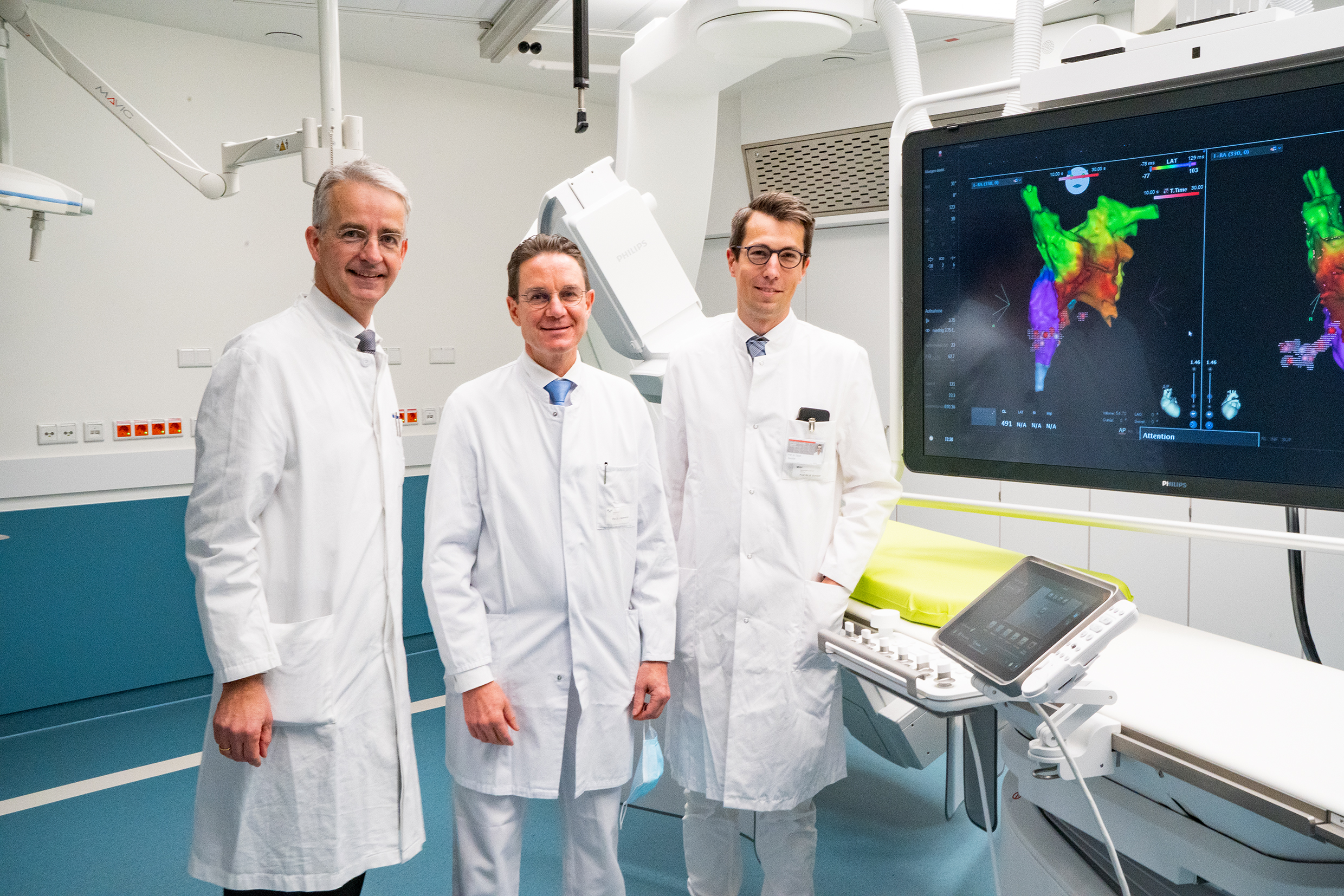The facility offers innovative technology for the diagnosis and therapy of cardiac arrhythmias. A new treatment method is now available for patients with atrial fibrillation.

Modern technology: Professor Dr. Frank Lammert, Vice-President of the MHH, Professor Dr. Johann Bauersachs, Director of the Clinic for Cardiology and Angiology, and Professor Dr. David Duncker, Head of the Hannover Heart Rhythm Centre (from left), in the new electrophysiology laboratory. Copyright: Mareike Heger / MHH
Stand: 10. Januar 2023
After an extensive renovation phase, the Hannover Medical School (MHH) now has a new electrophysiology laboratory: this is a cardiac catheterisation laboratory especially for patients with cardiac arrhythmias. The modern facility offers all diagnostic and therapeutic possibilities. It also has an innovative technique for treating atrial fibrillation, one of the most common arrhythmias. In this procedure, the cardiologists sclerotise diseased heart muscle cells with the help of electrical impulses. The new laboratory is part of the Hannover Heart Rhythm Centre (HHC). The HHC is a department of the MHH Clinic for Cardiology and Angiology under the direction of Professor Dr. Johann Bauersachs.
Examination with the aid of magnetic field navigation
There are many proven treatment options for patients with cardiac arrhythmias. They range from medication to catheter ablation, i.e. the obliteration of diseased heart muscle cells, to surgical measures such as the implantation of pacemakers, defibrillators or cardiac resynchronisation systems. The team at the HHC has the entire range of treatments available. During an examination in the electrophysiology laboratory, the MHH rhythmologists determine the type and mechanism of the cardiac arrhythmia and can - if necessary - also carry out a therapy directly. To do this, they insert an electrode catheter via a vessel in the groin into the relevant heart cavity. In the laboratory of the HHC, the examination is carried out with the help of modern magnetic field navigation, for example. "The flexible catheter scans the heart cavity and creates a three-dimensional map of it," explains Professor Dr David Duncker, head of the HHC. A high-resolution 3D mapping system gives the treating physicians a clear picture of the electrical signals in the heart. "It helps us to localise and treat the areas responsible for the cardiac arrhythmias even more precisely," explains Professor Duncker. On a large screen above the examination table, the team can follow the procedure live and call up other images that are important for the procedure, such as CT, MRI, X-ray or ultrasound images.
Catheter ablation with electrical pulses
"As a certified atrial fibrillation center, we are particularly proud that we can use a completely new ablation procedure in the electrophysiology laboratory to treat atrial fibrillation," says Professor Duncker. In contrast to the established forms of therapy, in which heat or cold is used to obliterate the diseased heart muscle tissue, electrical pulses are used in so-called pulsed field ablation. "With this method, we can specifically target only the diseased heart muscle cells. The surrounding tissue, nerves and vessels are spared. In this way, we can also exclude the possibility that the phrenic nerve or the oesophagus will be injured," explains Professor Duncker. The cardiologist sees the new procedure as a great gain. "It is gentler and faster and thus offers more safety for our patients." The HHC is the first facility in Hanover to offer pulsed field ablation.
New opportunities for cardiology training
In addition to innovative technology for the diagnosis and therapy of cardiac arrhythmias, the electrophysiology laboratory also offers new potential for training the next generation of cardiologists. For example, it is possible to record surgical interventions and incorporate them live into student teaching as case presentations. Another advantage is a pair of 3D glasses that the examiner wears during the procedure. The glasses can not only display additional information such as CT images. They are also able to record the wearer's gaze and show it to other people. "This is immensely helpful in the training of our junior physicians and our interns," says Professor Duncker, for whom the training of junior staff is very important. The HHC is a certified training centre for special rhythmology of the German Society of Cardiology.